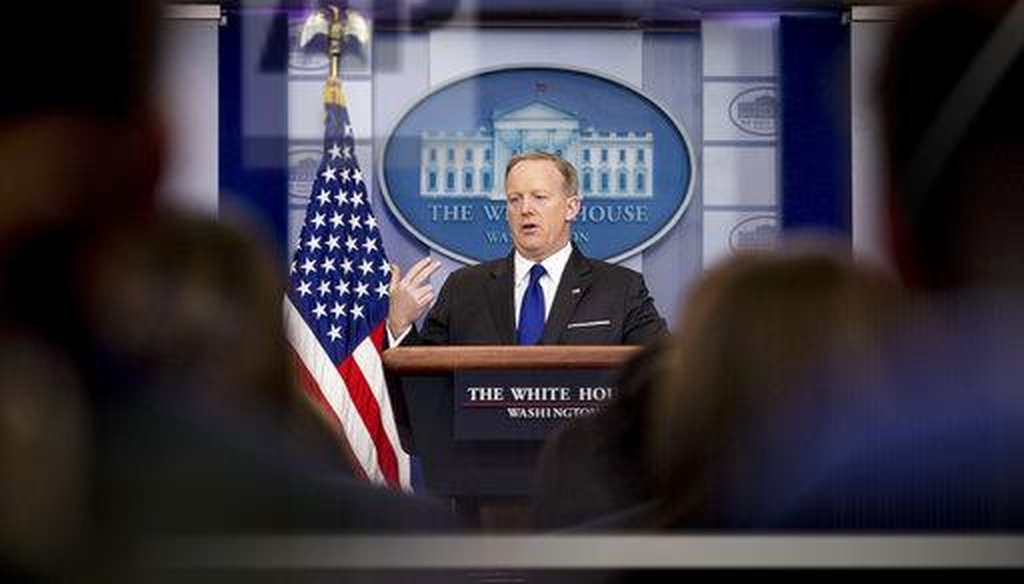



White House Press Secretary Sean Spicer fields reporter's questions during a press briefing / Credit: Associated Press
White House Press Secretary Sean Spicer addressed global food demand to commemorate National Agriculture Day on March 21.
"Global food demand is expected to increase by 50 to 97 percent by 2050," Spicer said, using the claim to support President Trump’s desire to reduce regulations affecting American farmers and ranchers.
We wondered how such an estimate would be created and if Spicer’s data was based on evidence.
Projections on food increases
Both the data the White House showed us and research we found supports the claim that food demand will increase in the coming decades. Yet estimates vary surrounding the level to which it will increase.
One study from 2014 in the academic journal Agricultural Economics stated food demand might increase by 59 percent to 98 percent between 2005 and 2050. Another study contributed to the National Academy of Sciences in 2011 said crop demand might rise by 100 to 110 percent between 2005 and 2050.
Those estimates are close to the increase of 50 percent to 97 percent Spicer mentioned, though Spicer’s claim didn’t specify a start date for his projection. (We asked for clarification but didn’t get a response.) The start date matters, because if it’s 2017 -- as a casual listener would probably assume -- then Spicer’s estimate is likely too high.
Harry Kaiser, a Cornell University professor and an expert in food demand, said about a 39 percent increase in global food demand seemed more accurate (though he said other factors, like global changes in diet, might contribute to a higher estimate). He calculated that figure based on projected increases in population multiplied by projected increases in per-capita food demand using 2012 data from the Food and Agriculture Organization of the United Nations.
"Bottom line: This is way lower than Spicer’s claim of between 50 to 90 percent growth in world food demand by 2050," he said.
Richard Waite, an associate from from the World Resources Institute’s Food Program also told us that Spicer’s estimate was too high.
He explained that forecasts of this nature "can be a little misleading" because the base year for frequently used data is often in the past. Waite estimated a roughly 45 percent increase in food demand from 2017, but noted that it was a fairly common "mistake" to use projected figures from 2006 in the way Spicer did. The World Resources Institute estimated about a 70 percent increase in global food demand between 2006 and 2050.
Reasons for increasing global food demand
Several factors impact rates of global food demand: growth in population and income are two of the most important ones.
Estimates show the projected world population will be around 9.6 billion by 2050, up from roughly 7.5 billion currently, and per-capita income is expected to rise to 1.8 times what it was in 2012.
Population increases the number of mouths to feed, while income growth tends to increase the amount of calories the people eat. Income increases can also create a shift in diet as lower-income individuals may have better access to protein-heavy foods like livestock and fish as their incomes rise.
For example, the World Resources Institute expects a 23 percent global increase in consumption of livestock and cattle between 2006 to 2050.
Our ruling
Spicer said that global food demand would increase by 50 to 98 percent by 2050. Recent projections agree with general thrust of his forecast, but it seems likely that Spicer’s claim is a little too high to be completely on target. We rate the claim Mostly True.
https://www.sharethefacts.co/share/8e0ffe0c-c964-466d-8119-10dd50b67863
David Tilman et al, Global food demand and the sustainable intensification of agriculture, March 22, 2017
Hugo Valin et al, The future of food demand: understanding differences in global economic models, Abstract, March 22, 2017
Food and Agriculture Organization of the United Nations, How to Feed the World in 2050, March 22, 2017
Food and Agriculture Organization of the United Nations, WORLD AGRICULTURE TOWARDS 2030/2050, The 2012 Revision, March 23, 2017
World Resources Institute, The Global Food Challenge Explained in 18 Graphics, March 22, 2017
Harvard Business Review, Global Demand for Food Is Rising. Can We Meet It?, March 22, 2017
PolitiFact, Sen. Roy Blunt right about future demand for food, March 22, 2017
Congressional Quarterly, White House Holds Regular News Briefing, March 21, 2017
Phone and email interview, Harry Kaiser, professor of applied economics and management at Cornell University, March 23, 2017
Email interview, Steven Cheung, White House spokesperson, March 23, 2017
Email interview, Richard Waite and Craig Hanson, World Resources Institute, March 23, 2017
Email interview, Ron Sands, senior economist, United States Department of Agriculture Economic Research Center, March 24, 2017
In a world of wild talk and fake news, help us stand up for the facts.
